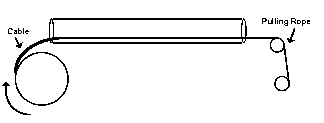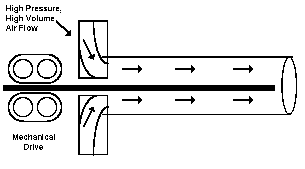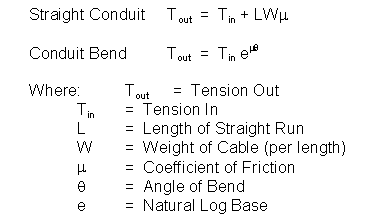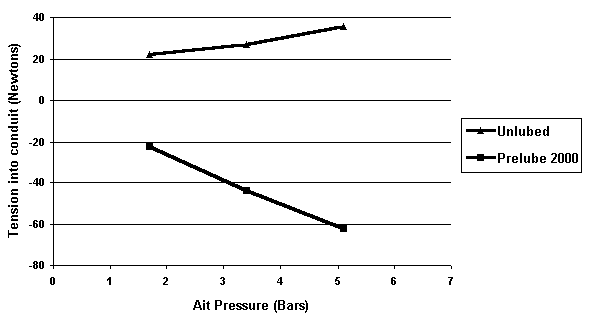| |
|||||||||
| |
|
|
|
|
|
|
|
||
| Home | About | Literature | Site Map | MSDS | Contact | Engineers | Shows | Links | Samples | RFQ | Catalog Numbers |
Both outside plant and in-building communications cable are often placed in conduit or duct. The conduit provides protection from both physical and environmental abuse. In underground installation, conduit protects cable from shifting rocks, aggressive rodents, and/or damage from hand shovels. Underground cable that is in conduit is easy to replace or upgrade. The old cable can be pulled out of the conduit and the new pulled in without extensive and expensive digging.
In metropolitan areas, multiple conduits are often grouped as "duct banks." Placing cable into empty ducts in these banks allows changes and growth of the city’s cable infrastructure without major traffic disruptions from cutting and trenching of the street.
A large percent of underground fiber optic cable is installed in conduit. Because fiber optic cable is typically 10 - 20 mm in diameter, it has lower breaking strength and is more easily damaged than a 100 mm twisted pair copper cable. Conduit offers needed protection for this fiber optic cable.
Cable Pulling
 The most common method of installing cable into conduit is called "cable pulling" (Figure 1). Cable pulling is well known to cable installers throughout the world. First a line is threaded through the conduit; the line is attached to the cable; and then the line is used to drag the cable back through the conduit. For more than 50 years, millions of kilometers of electrical and communications cable have been installed using this basic method.
The most common method of installing cable into conduit is called "cable pulling" (Figure 1). Cable pulling is well known to cable installers throughout the world. First a line is threaded through the conduit; the line is attached to the cable; and then the line is used to drag the cable back through the conduit. For more than 50 years, millions of kilometers of electrical and communications cable have been installed using this basic method.
There is a "technology" of cable pulling. How can one determine the maximum distance that a cable can be pulled without damage? How can pulls be optimized to minimize splices and splicing expense? Proper answers to these questions mean better, more efficient cable installations, with less damaged cable and longer cable life.
Cable Blowing
 Another way of installing cable in conduit, especially suitable for light weight fiber optic cable, is laminar high speed air installation or "cable blowing" (Figure 2). Compressed air flow of greater than 10 cubic meters/min and an entry pressure of greater than 7 bar carries the cable through the conduit using the blowing air force pushing on the jacket.
Another way of installing cable in conduit, especially suitable for light weight fiber optic cable, is laminar high speed air installation or "cable blowing" (Figure 2). Compressed air flow of greater than 10 cubic meters/min and an entry pressure of greater than 7 bar carries the cable through the conduit using the blowing air force pushing on the jacket.
Cable Strength Limitations in Pulling
The first question in pulling any type of cable is how hard can you pull on it without damaging it; i.e., with how much force? The maximum recommended tension varies with both the size and type of cable. Fiber optic and coaxial cables typically have tensile strengths of 200 to 2500 Newtons. Large copper cables may have tensile strengths as high as 15 kN. The cable's manufacturer can provide the maximum installation tension for any particular cable. To properly pull the cable, this maximum allowable tension must be known and respected by the installer
Frictional Force in Cable Pulling
Limits in the length of cable pull come from the need to keep the pulling force below the cable’s maximum tension. Force is required to pull cable through conduit to overcome the cable’s frictional resistance to movement.
Frictional resistance is measured with a "coefficient of friction". How can we define this "coefficient of friction" (COF)?
Let's start with a simple physics class example . . . a wooden block (say, 5 kgs in weight) on a horizontal steel plate. Say it takes 2 kgs force (19.6 N)) to pull (drag) the block across the plate. The coefficient of friction (wood on steel) is defined as the ratio of this "dragging force" (2 kgs) to the normal force (weight of 5 kg). In this case, the friction coefficient would be .4. Note that COF is a dimensionless number.
Experience tells us that if we replace the wooden block with a 5 kg rubber block, it will take a greater force to drag the rubber block (say 6 kgs force). The measured coefficient of friction (rubber/steel) would be 1.2. What's important to note in these examples is that there is no one coefficient of friction. The friction coefficient varies with the rubbing surfaces.
Replace the block with cable and the plate with conduit, and we have cable pulling . . . with a few complications. Neither the cable nor the conduit is flat. There may be more than one cable, which can result in complex rubbing surfaces. Pulls are not straight, so forces other than gravitational weight occur at conduit bends. Finally, pulling lubricants change and lower the friction coefficient.
Cable Pulling Lubricants
Polywater® Pulling Lubricants play an important part in efficient pulls. Lubricants reduce the coefficient of friction, and thus the force required to pull the cable. In practice, this can mean a reduction in tension of 35 to 95 percent, depending on conduit route and cable jacket type. Not only must the lubricant be slippery, but it also must be compatible with the cable jacket with no long term adverse effects.
While oils and greases sound like fine cable pulling lubricants, they're not. These materials can swell and weaken the plastic jacket on the cable. Some of the wax and soap lubricants used on electrical cables are not suitable for communications cable, as they can stress crack polyethylene jacket. Modern Polywater® Cable Pulling Lubricants are water-based polymer materials, specially compounded for different types of cable and pulling environments. Polywater® Lubricants have been used for over two decades to install over 50,000,000 meters of cable.
American Polywater has extensively researched friction and lowering friction by using pulling lubricants. See the bibliography for references on this research.
Tension Estimation in Cable Pulling
Once we have determined a valid coefficient of friction, cable pulling tension can be calculated using the cable pulling equations. The equations apply the physics from our block/table example to the unique character of cable pulling. This includes the non-gravitational forces in conduit bends.
Looking at a simplified form of the equations will clarify:

Note how significant changes in µ (friction coefficient) can be, especially in conduit bends, where this friction variable is in the exponent. Inaccurate coefficients of friction lead to poor correlation of tension calculations with actual tensions. Unfortunately, it is in multi-bend pulls, where the tension and sidewall pressure are of most concern, that the use of an inaccurate coefficient of friction produces the greatest error.
Pull-Planner™ Has Friction Database
We’ve seen that coefficient of friction varies with cable jacket, conduit type and lubricant type, and that it’s necessary to use accurate coefficients to calculate meaningful pulling tensions.
American Polywater's laboratory has developed extensive friction data for different cable jacket and conduit types. This data is in an internal data base in our Pull-Planner™ Software.
The Pull-Planner™ provides a convenient way to calculate cable pulling tensions on a personal computer. It enables "what if" scenarios with cable, conduit, pull length, COF, incoming tension, jam ratios, and more. Lubricant quantities needed can be calculated, and calculations can be saved or printed out. The full version of the Pull-Planner™ is a Windows™ based program that can be run on 16 or 32 bit systems, and calculates in metric or English units.
Read our Technical Talk newsletter issue on this software, or click here to ORDER for only $129.
Friction in Cable Blowing
Rather than lowering tension, reducing friction in cable blowing reduces the resistance to the combined mechanical and moving air pushing forces. This means the cable goes farther before it stops (longer installations) when all other variables are held constant.
Figure 3 below presents data from a lubricated and an unlubricated blowing experiment. The mechanical pusher was deactivated and the force required to push or hold back a cable was measured versus the incoming air pressure. The data indicates an unlubricated COF of .5 to .6 and a lubricated COF of .1 to .2 using our Polywater® Prelube™ 2000. Cable can be blown 2.5 to 5 times farther with differences of this magnitude.

Lubricant Application in Pulling
There are a number of forms and packages for Polywater®Lubricants to support different types of application. Liquid lubricants work well in underground situations where the lubricant can be poured into the up-turned duct or cable feeder tube by using a funnel. For hand application, where the lubricant is lifted in a cupped hand and applied to the cable, gel lubricants work the best.
It is a good procedure to put some of the lubricant in the conduit just before the pull and to spread it with a sponge spreader attached to the winch line during the pull. This deposits lubricant in front of the cable. In larger conduits (>75 mm) with bigger cables, Front End Packs™ (bags of lubricant) can be attached to the winch line and slit open as they enter the conduit in front of the cable. It is important to get the lubricant spread throughout the conduit to every point where the cable rubs.
Lubricant pumps are available from American Polywater. For additional information, see the references section.
Lubricant Application in Blowing
Polywater® Prelube™ 2000 should be coated on the conduit walls before the cable is inserted in the conduit and cable blowing begins. This is best done with a sponge spreader which is blown through the duct with the lubricant in front of it. This is usually done right after the duct "proving" and cleaning process.
Unique Fiber Optic Placement Techniques
Several techniques can be used to place almost unlimited lengths of uninterrupted (unspliced) fiber optic cable. In "figure-eighting," the total length of cable is pulled through the first section of conduit. The excess is laid out neatly in a figure-eight pattern (counter twists). The figure-eight of cable is then flipped over and the pulling is begun again into the next section of conduit. This procedure can be done a number of times. Care should be taken to keep the cable clean and protected while it is laid out.
Bi-directional pulling also involves figure-eighting, but no excess is pulled through the first conduit segment. Instead, the second pull is made in the opposite direction after the cable is figure-eighted off the reel onto the ground. The reel effectively sits at the middle of the run.
Mid-assist pulling involves special intermediate pullers usually based on large diameter capstans or parallel caterpillar tracks. These devices actually pull on the cable and then feed it back into the next section of conduit with no tension. In a sense the installation becomes several shorter pulls with several simultaneously operating pullers.
For shorter light pulls, manual mid-assist (hand-over-hand) can be used with the help of SureGrip™ Nonslip Gloves to lower tension with a conscientious and properly coordinated field crew.
Summary
Pulling or blowing cable is not difficult. Pullers must be careful not to put excess tension on the cable as it's installed. The special lubricants and equipment made for this task can make it straightforward and efficient, with no damage to the cable.
References
Click here to Add Your Name To Our Mail List
Use this free Calculator to determine duct factor in fiber pulling
View a free streaming video on Fiber Optic Cable Pulling & Lubrication
Ask for Polywater® products by name at your local authorized distributor
Home |
About |
Site Map |
Literature |
Samples |
Links |
Reps |
Videos |
Pumps |
RFQ
Codes |
Engineering |
Shows |
Spotlight |
Newsletters |
MSDS |
Translations |
Contacts |
Jobs

11222 60th ST N | Stillwater, MN 55082-9310 USA
1-(651) 430-2270 (Voice) | 1-(651) 430-3634 (Fax)
1-(800) 328-9384 (Toll-Free US/Canada Only)
Copyright © 2001 - 2015 American Polywater Corporation | ![]() 6/5/15
6/5/15